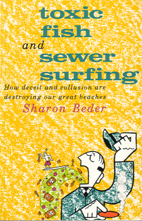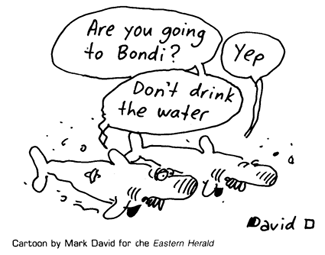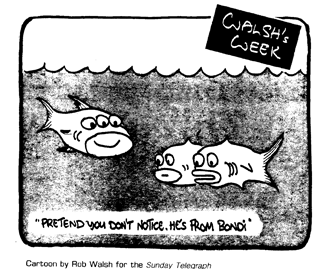
by Sharon Beder
first published by Allen & Unwin, Sydney, 1989
Introduction
Sewers seaward
Toothless watchdog
Toxic fish
Sewer-side surfing
Public relations battle
Events of 1989
Beyond Sydney
Conclusion
Bibliography
One of the principal ways that toxic chemicals get into fish is through the accumulation of these substances, such as heavy metals, pesticides and organochlorines, in the seabed sediments. Yet this has never been properly investigated. Caldwell Connell stated in their 1976 report that ‘a detailed investigation of levels of pesticides and heavy metals in the marine environment is beyond the scope of this study’. In the 1979 Environment Impact Statements which were also prepared by Caldwell Connell and based on their earlier studies, the possibility of bioaccumulation of toxic substances was dismissed as unlikely since no serious accumulation of these toxic materials had been observed in sediments near the existing outfalls. But how carefully had they looked for sediments?
They had only taken samples in three places for analysis of toxic contamination and these were some distance away from the existing outfalls. In a confidential report the SPCC noted that: ‘The statistical significance of single samples and the validity of a sampling technique which does not segregate undisturbed surface material must be brought into question.’
Caldwell Connell assigned no importance to the fact that elevated levels of heavy metals and DDT were found in the sample taken nearest to Malabar and argued that although ‘the presence of transient sludge layers’ on the ocean floor was noted by SCUBA divers, this material ‘appeared to be deposited only during periods of low current velocities and was dispersed under the normal current regime’. Jump Camera photographs taken in water 45 metres deep and deeper of the North Head outfall, and therefore at some distance from the shoreline discharge, also failed ‘to show any accumulation of sediments which could be likened in particle size to digested sludge. These meagre observations were sufficient justification for Caldwell Connell to assume that sludge did not accumulate, yet they made no attempt to explain the accumulation of heavy metals and DDT in their Malabar sample.

Others who read the environmental impact statements were less optimistic than the Board and its consultants. A major concern of the Department of Mineral Resources was the potential accumulation of deposits of solid particles which might in turn lead to a concentration of heavy metals and toxic chemicals. They were sceptical of Water Board claims. ‘It is difficult to understand that these particles do not go somewhere specific where they accumulate.’
The Australian Museum, which had conducted ecological surveys of nearshore waters for the Water Board, claimed that particles from the diffuser which fell into the mud/clay range would be likely to be deposited in a relatively stable region of mud and that heavy metals and other industrial wastes which might behave like mud- or clay-sized particles were likely to also be deposited in this stable zone of muddy sediment. Such materials could then be assimilated by bottom-dwelling organisms and enter the tissue of fish passing through the area. ‘Such a situation could be harmful since the professional fishing grounds of Sydney are located in this region’ (Clean Waters Advisory Committee, Business Papers, 10/9/87).

Caldwell Connell again concluded in 1982 that there would not be any long-term accumulation of toxic sediments on the seabed, nor any consequent damage to the environment. This contrasts with an SPCC finding that adverse impacts of sewage sludge disposal to the ocean have been observed all over the world. The SPCC report cited reports, most of which predated the Caldwell Connell report, that showed that in the New York Bight many bottom-dwelling invertebrates, which are an important food organism for fish, seem to have disappeared. At the Hyperion outfall in Los Angeles it was found that even when diluted 600 times sewage sludge was slightly toxic to the development of sea urchin embryos. Numerous diseases in marine organisms had been associated with sludge discharges in the States and in Germany. The SPCC observed that: ‘None of the studies undertaken of Sydney thus far have attempted to account for the fate of the sludge which has been discharged through the existing shoreline outfalls.’